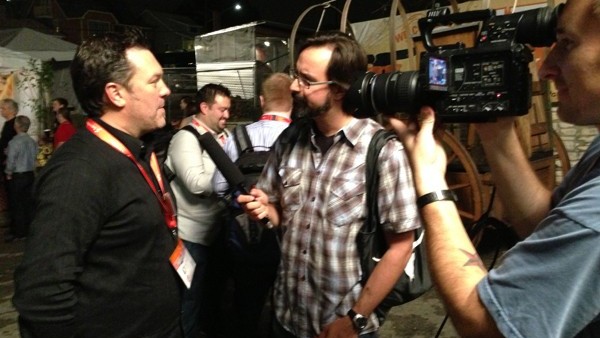Events present great opportunity.
That’s because events are where people act interested. Our minds are bit more open to new things—new people, new products, fresh perspectives, or maybe we’re just drunk on free swag. It’s great that attendees are friendly and ask about your products, services, etc. On social media, there’s also increased chatter—conversations about the event, panels, booths, giveaways, networking.
Yes, events are where people act interested, online and offline. But once the event is over, so is the enthusiasm.
So, how do we build on that momentum we’re creating at the event? And how can we keep it going days after the event?
My company does video content, so I’m sure it comes to no surprise that we’d turn to our core skill set to address this challenge at the events we depend on. But we didn’t want to just use it in a sedentary, passive way. We wanted genuine engagement. We wanted relevant attendees to be as invested in our event efforts as we were. “We wanted relevant attendees to be as invested in our event efforts as we were.” Playing videos on an endless loop at our booth wasn’t going to cut it.
We decided to employ an “Agile Video Content” strategy.
In a nutshell, Agile Video Content refers to engaging, on-message videos produced on the spot, uploaded, and distributed usually in about an hour.
W2O Group Managing Director and author of Location Based Marketing for Dummies, Aaron Strout on agile content:
“Increasingly, smart marketers are realizing the value of creating,
capturing and activating content — particularly agile video content — at
events. Not only do social conversations tend to spike up around such
events but there also tend to be a larger than normal set of influencers
and customers in attendance of these events.”
So here’s what we set out to do:
Our video content crew would shoot footage and interview relevant participants, all while collecting their contact and social media info. This was touch point 1.
Then, using the contact info & social media info, we engaged w/ all of the participants immediately, thanking them for participating. Touch point 2.
Once the video content was complete, we engaged them again letting them know that the video they “starred in” is online and should be shared. Touch point 3.
The following day, we sent a follow-up blast via email. Touch point 4.
This was our plan. So, did it work?
We did this for 3 different events, producing 4 agile video content pieces.
Here are the stats:
Social Media
90%
interviewees that had an active twitter account watched the video at the event.
80%
interviewees that had an active twitter account followed us. (@UPGVideo)
60%
Click Thru Rate(navigating to our website) via the next day follow up email blast—distribution list included many who were NOT interviewed.
40%
of all “opens” driven by email forwarding
Web traffic
200%
increase in web traffic on event day and the day after.
150
minutes of additional time spent on the website during the following week.
As you can tell, the numbers tell a positive story.
4 Reasons Why It Worked:
- We made the whole campaign about the attendees. This is paramount. You won’t hear anything about UPG Video in the examples below. This approach is also reflective of the nature of today’s social web. To engage, brands need to make it about the reader, viewer, consumer.
- People want to share. Whether it’s just because they “starred in” the video or because the topic is relevant and entertaining, people viewed the content and distributed it. What’s also encouraging is that a large portion of sharing was via email and not just social media.
- The content was relevant. The topics discussed in the video were relevant to a large portion of people at the event or following online, not just those interviewed. Needless to say, selecting the right topic is very important.
- It was relatively cheap. Yes, this was a soft cost for us but even if it wasn’t it would be a great investment considering the ROI. Depending on scaling, this could be easily executed by pro’s for well under $10K.
I think it’s clear that relevant content is a great approach, especially when paired with other big picture efforts. But it’s not always just about the “what.” Sometimes it’s also about the “when.” And for us and the Agile Video Content approach, the “when” is now.
Examples of Agile Video Content
The topic of this piece coincided with a panel we organized on the importance of relevant engagement. It became our theme. The panel’s title: “Don’t let your brand be the drunk uncle of the social web.”
“What NOT to do on social Media”
This topic has a more general appeal. The participants seemed to enjoy it. Pretty fun, indeed.
“What’s the Best/Worst Tech Gadget Ever?”
The last example has far more of a niche appeal. It’s about Microsoft Sharepoint. Needless to say, the event had a serious IT presence.
